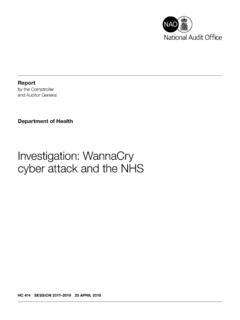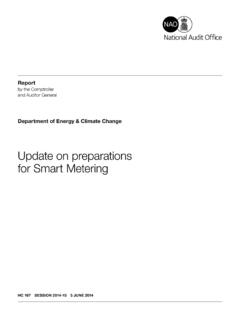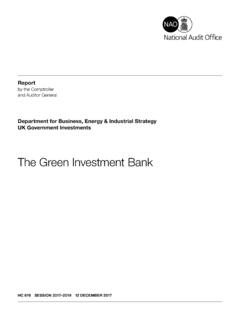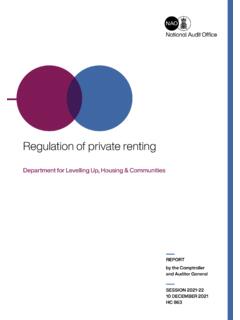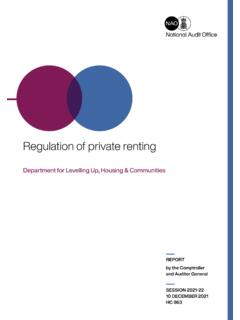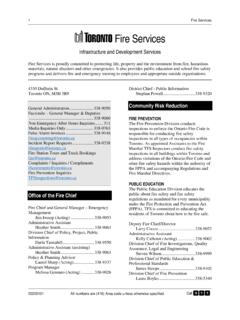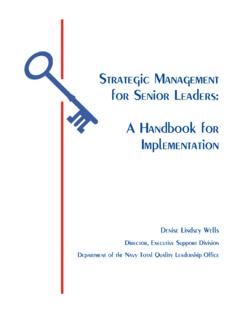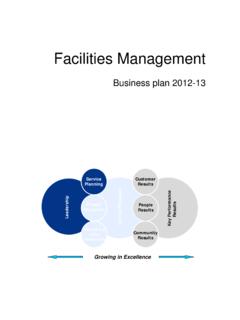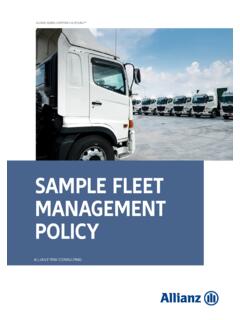Transcription of Commercial and contract management - National Audit Office
1 Commercial and contract management : insights and emerging best practiceNovember 2016 The National Audit Office (NAO) scrutinises public spending for Parliament and is independent of government. The Comptroller and Auditor General (C&AG), Sir Amyas Morse KCB, is an Officer of the House of Commons and leads the NAO. The C&AG certifies the accounts of all government departments and many other public sector bodies. He has statutory authority to examine and report to Parliament on whether departments and the bodies they fund have used their resources efficiently, effectively, and with economy. Our studies evaluate the value for money of public spending, nationally and locally. Our recommendations and reports on good practice help government improve public services , and our work led to audited savings of billion in & Production by NAO External Relations DP Ref: 11318-001 National Audit Office 2016If you would like to know more about the National Audit Office s Commercial and Contracting programme of work, please contact:Joshua Reddaway Director, Commercial and Contracting VFM 020 7798 7938 CommercialstrategyCommercialcapabilityMa rketmanagement& sourcingContractapproachContractmanageme ntContractlifecycleTr ansition& terminationNationalAuditOfficeThe National Audit Office team for this work consisted of.
2 Andrew Denney, Iain Forrester, Catriona Sheil, Fedra Vanhuyse, David Wilson, and Emma Willson, under the direction of Joshua interactive publication draws on our audits of government contracts and engagement with government to provide practitioners with insights on the new, emerging higher standard for government contracting. What is this?In this publication we set out our insights on some of the areas where contracts go wrong, the warning signs that we look for, and the examples of emerging good practice we have seen across government. We draw on many of our previous reports, our engagement with government as it has sought to improve its Commercial capability, and our discussions with practitioners about the challenges they face. We also set out our framework for auditing Commercial relationships which we intend to increasingly use to explore emerging good practice.
3 The specific questions we ask will vary for each have we produced this?The public sector now buys more in than it spends on delivering services itself. It is also buying increasingly complex things in increasingly complex ways. Public sector requirements, such as transparency, fairness and achieving value beyond the core contract terms, make this scandals in 2013 served as a wake-up call to government. It realised that it had consistently underinvested in its Commercial capability and the management of its contracts. While contractors behaviour has sometimes been reprehensible, government should not have allowed contractors to behave in this government has reacted to these scandals, it has also come to appreciate the need to improve its Commercial capability and the value of managing its contracts 2013, government turned to our good practice framework for contract management , originally published in 2008, to assess its management of contracts.
4 We developed this framework with government through workshops with practitioners. We believe it still stands as a practical guide to the functions that government must carry out for operational contracts. But having seen it used over the past few years, we believe that although necessary, the framework is not sufficient; government needs to develop a much higher standard if it is to achieve its contracting goals consistently. In striving to improve, government departments have thus found themselves inventing good practice , rather than looking to implement an existing model. Our assessment is that things are improving, but still far from perfect. We want to challenge government to establish and meet a much higher standard so it can achieve its contracting goals. At the same time, our new Audit framework for Commercial relationships aims to provide some consistency in the way we view contracts so that we can enhance our understanding of what is good practice just as government raises its standards.
5 Who is it for?We have aimed our Commercial and contract management insights and emerging best practice at public sector leaders responsible for Commercial relationships and contracts, and those practitioners managing contracts, both in the Commercial function and more should it be used?We cover 7 areas of our Commercial relationships framework and highlight some of the issues we have found for each area. These show what we think are the most important areas for government to think about and are not an exhaustive checklist or comprehensive guidance on how to procure and manage contracts. Our thoughts on emerging best practice provide ideas of what might help, as government continues its journey to work out how to best contract for what it needs and set the high standards needed. Revised Commercial standards published in October 2016 are a positive step on this journey government now needs to ensure these standards are implemented and continue to raise its expectations.
6 Readers may choose to read this document as a whole, or go straight to our list of the 20 important insights for government to think OverviewHomeNavigationCommercialstrategy CommercialcapabilityMarketmanagement& sourcingContractapproachContractmanageme ntContractlifecycleTransition& termination7652341 Why is Commercial and contract management important? What are we doing?How to use this document The Commercial relationship lifecycle 20 insightsWhat does our emerging best practice mean for departments and government?The public sector spends 242 billion a year with private and voluntary sector suppliersGovernment relies on suppliers across a range of areasGovernment is improving contract management on three levelsThe public sector spends 242 billion a year with private and voluntary sector suppliersThe public sector spends more money on contracts than it spends on providing services itself.
7 During 2014-15 it spent 242 billion (31% of total government spending) on external suppliers, compared with 194 billion on staff costs. Suppliers now play a significant role across the public sector. They carry out government work including complex projects, back- Office administration and public-facing s large contracts include: HM Revenue & Customs information, communication and technology services contract , known as Aspire ( 11 billion total contract cost) Ministry of Defence s defence information infrastructure contract ( 4 billion) Department for Transport s contract for the Northern Rail franchise ( 2 billion) HM Treasury s outsourced service contract for National Savings & Investments ( 1 billion)Largest categories of public sector spending 2014-1530%Benefits 218 billion26%Staff costs 194 billion31%Contracts 242 billion (includes 50bn capital)11 A small amount of this capital expenditure is capitalised staff costs and the majority is contracted with delivery.
8 Whole of Government Accounts 2014-15 734 billion Expenditure4 OverviewHomeNavigationCommercialstrategy CommercialcapabilityMarketmanagement& sourcingContractapproachContractmanageme ntContractlifecycleTransition& termination7652341 Why is Commercial and contract management important? What are we doing?How to use this document The Commercial relationship lifecycle 20 insightsWhat does our emerging best practice mean for departments and government?The public sector spends 242 billion a year with private and voluntary sector suppliersGovernment relies on suppliers across a range of areasGovernment is improving contract management on three levels1 of 2 Government relies on suppliers across a range of areasThe 242 billion that the public sector spends through contracts comprises: 192 billion on good and servicesCentral government departments & arm s-length bodies 62 billion 54 billion NHS 65 billion Local government 9 billion Public corporationsCOUNCILO ther central government entities and devolved spending 19 billion 50 billionCapitalCapital spending is not separated out by sector in the Whole of Government AccountsSource.
9 Whole of Government Accounts 2014-155 OverviewHomeNavigationCommercialstrategy CommercialcapabilityMarketmanagement& sourcingContractapproachContractmanageme ntContractlifecycleTransition& termination7652341 Why is Commercial and contract management important? What are we doing?How to use this document The Commercial relationship lifecycle 20 insightsWhat does our emerging best practice mean for departments and government?The public sector spends 242 billion a year with private and voluntary sector suppliersGovernment relies on suppliers across a range of areasGovernment is improving contract management on three levels2 of 2 Government relies on suppliers across a range of areas continuedCentral government contract spend categories 2014-15 Consultancy and contingent Labour01234567 ICTF acilitiesDefenceProfessional servicesConstructionIndustrial servicesLegal aidLogisticsEnergy and fuelsWefare to workEngineering goodsWorld programmesTravelLearning and developmentOffice solutionsSocial careOperational goodsClinical and medicalFleetCommunicationsResearchPrint and print managementPersonnel relatedEmergency and rescueWaste managementUncategorisedGovernment spend ( billion) cash basisSource.
10 Cabinet Office Spend Analytic (Bravo)6 OverviewHomeNavigationCommercialstrategy CommercialcapabilityMarketmanagement& sourcingContractapproachContractmanageme ntContractlifecycleTransition& termination7652341 Why is Commercial and contract management important? What are we doing?How to use this document The Commercial relationship lifecycle 20 insightsWhat does our emerging best practice mean for departments and government?The public sector spends 242 billion a year with private and voluntary sector suppliersGovernment relies on suppliers across a range of areasGovernment is improving contract management on three levelsGovernment is improving contract management on three levelsGiven the importance of contracting, government needs to get it right. Since 2013, it has invested in understanding and improving Commercial and contract management .


